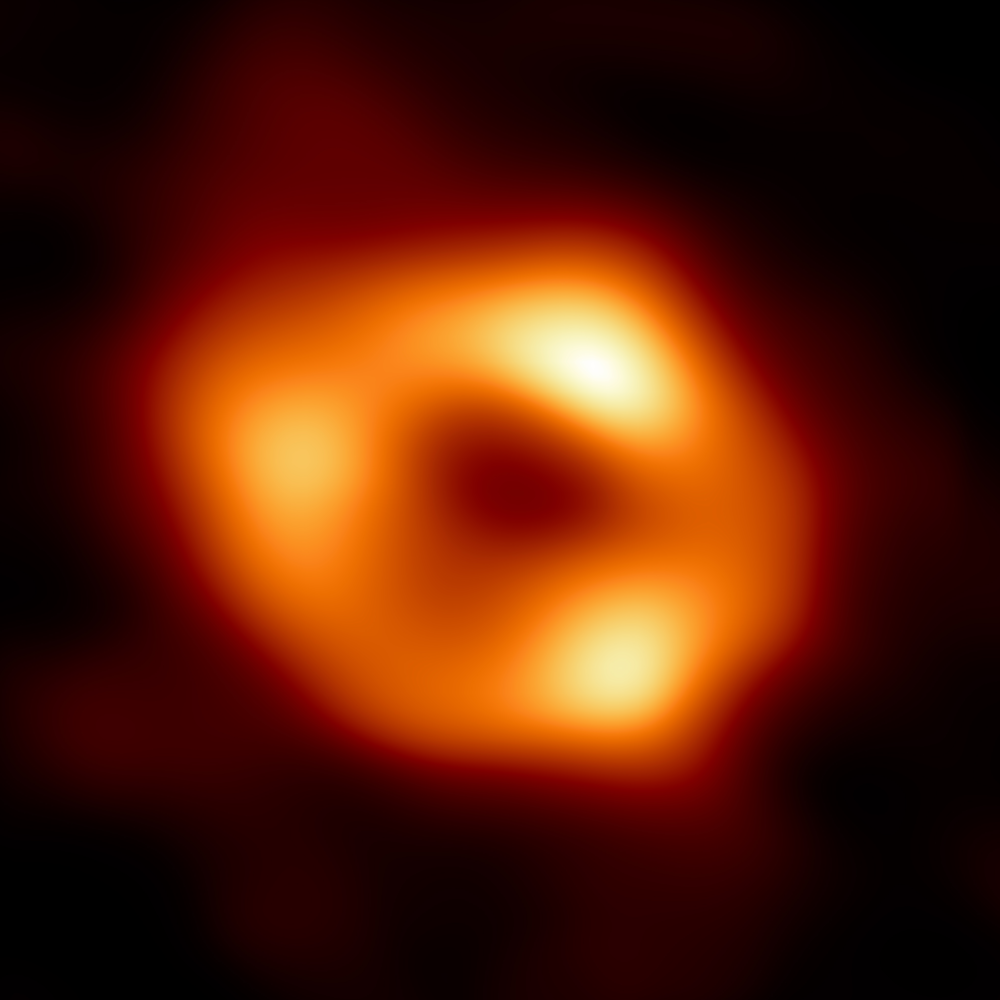First Image of the Milky Way’s Black Hole
Three years ago, researchers revealed the first ever picture of a black hole, which depicted a supermassive black hole over 50 million light years away from Earth, in a galaxy called M87. Those same scientists have now unveiled the second-ever black hole image, which shows a dark object much closer to home. “Today, the Event Horizon Telescope [collaboration] is delighted to share with you the first direct image of the gentle giant in the center of our Galaxy, Sagittarius A*,” said Feryal Özel, an astrophysicist at the University of Arizona in Tucson. That image—revealed earlier today at multiple press conferences around the world—shows a glowing orb with a distinct black spot in its center.
Sagittarius A* (Sag A* for short) sits 26,000 light years from Earth and has a mass about 4 million times that of the Sun. Scientists have long suspected that this object is a black hole because of the way stars orbit around it, said Michael Johnson, an astrophysicist at the Harvard-Smithsonian Center for Astrophysics, who worked on making this image. “The stars gave us a tight prediction for something that was completely unseen,” he says. But, with no visual evidence, scientists were unable to confirm that idea.
To image Sag A*, scientists used the Event Horizon Telescope (EHT)—a global network of eight radio dishes that simultaneously gather data. The telescope collects light emitted from glowing gas orbiting around a target object, allowing scientists to “see” how the object’s gravity bends light. If the bending is substantial, the object can be confirmed as a black hole.
The data for this image, like the data used for the image of M87*, were collected in 2017. But it took significantly longer for the team to put the Sag A* picture together—a process that required using different “snapshots” from the EHT radio dishes. The dishes work in pairs, and the image resolution depends on the pair separations and orientations relative to the object of interest. Making a perfect image would require having pairs of dishes with all possible separations and orientations, which the EHT doesn’t have.
Earth’s rotation helps fill in some gaps, but it isn’t enough—said Katie Bouman, an engineer at Caltech who coleads EHT’s imaging group. Bouman likened the imaging process to that of trying to guess a song played on a piano that is missing keys. “Since we don't know when the missing keys should be hit, there’s an endless number of possible tunes that could be playing,” she said. “Nonetheless, with enough functioning keys, our brains can often fill in the gaps to recognize the song correctly,” and the same goes for recreating a black hole image. That worked for M87*, but for Sag A* there was another complicating factor—the fast-moving gas that orbits around the black behemoth.
The gas around Sag A* completes a full orbit around the black hole in minutes, a fraction of the time it takes gas to orbit M87*. In fact, the Sag A* gas orbits so quickly that it executes multiple rotations of the black hole in the time it takes the EHT to collect one set of data, creating motion blur in the same way the flow of water over a waterfall clouds a long-exposure photograph. “The material was swirling around Sag A* so quickly that Sag A*’s appearance could change from minute to minute,” Bouman said. “This is a bit like changing the key of the song as we are playing it on our broken piano.”
To mitigate these problems, the EHT team spent the past few years developing algorithms that help recover a picture from incomplete data. For Sag A*, the method involved producing tens of thousands of images, each of which is consistent with the EHT observations but contains different guesses for the missing data. The team was then able to narrow down those guesses and recover the most likely underlying structure of Sag A*. “Coming to this conclusion took years, but we never backed away from the challenge,” Bouman said.
It’s a “tremendous pleasure” to finally see an image of Sag A*, says Alex Lupsasca, a black hole theorist at Princeton University, who was not involved with the project. He remarks that the glowing donut we see is not a single image of Sag A*, but a probability distribution over many possible images compatible with the data. But, for him, that doesn’t detract from the result. “This breakthrough pushes the boundaries of our present technology and opens the door to future observations with even more exquisite precision, both from the ground and eventually from space.”
That sentiment is echoed by Eliot Quataert, an astrophysicist at Princeton University. “This is an incredibly exciting result, and I am in awe of the amazing work done by the EHT team,” he says. Quataert adds that for him the key result is that the image is consistent with previous knowledge of this black hole. “This did not have to be the case,” he says. “It’s remarkable.”
–Katherine Wright
Katherine Wright is the Deputy Editor of Physics Magazine.




